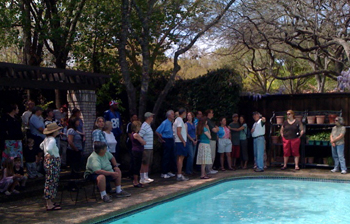 By Robin Sowton
By Robin Sowton
March 28, 2011
Last weekend, Dr. John and Margie Haley shared with over 50 interested local residents how they have put sustainable living in action at their White Rock Lake home.
The house uses solar energy for electricity and hot water. Solar panels on their roof tied in to a system in the garage which uses an inverter and backup batteries.
They have found this system also useful during power outages in the area. They isolated circuits to a panel for specific things that they wanted on during a blackout. When the power goes out, the inverter automatically feeds the panel from the batteries. Dr. Haley said that when this has happened, it is so fast that that the lights don't even flicker.

The Haleys grow vegetables in two different ways. They have a traditional organic garden and they have an aquaponics system. An aquaponics system is where you raise fish in a tank and then use the by-products in the water to provide nutrients to the vegetables--raising fish and growing vegetables at the same time. David Pennington was there to explain how these systems work. He said that although the Haley's system is in a sunroom getting lots of natural light, you would usually want to supplement that with LEDs.
 He recommends using Tilapia as the fish for these systems because they are omnivores and can handle lower oxygen content. They can also handle dirtier water which is good because plants like high-nutrient murky water. But he cautioned that you need to maintain the right water balance as too many fish can 'trash the system.' The water's temperature must also be balanced between 60-80 F. With the Haley's system, they bring in water from their rain harvesting system and use a pump to exchange the water.
He recommends using Tilapia as the fish for these systems because they are omnivores and can handle lower oxygen content. They can also handle dirtier water which is good because plants like high-nutrient murky water. But he cautioned that you need to maintain the right water balance as too many fish can 'trash the system.' The water's temperature must also be balanced between 60-80 F. With the Haley's system, they bring in water from their rain harvesting system and use a pump to exchange the water.
Chickens are also raised there to provide fresh eggs. They are kept in a nice spacious, but 'maximum security' coop and outdoor pen, due to some earlier raccoon attacks that took out half the population. One of the chickens' favorite treats are grubs, which are the result of throwing kitchen scraps into a biopod composter bin. The way this works is that black solider flie--not related to house flies or blowflies--find the rotting material and lay their eggs in it. When the larvae hatch, they feed on the waste.
One of the chickens' favorite treats are grubs, which are the result of throwing kitchen scraps into a biopod composter bin. The way this works is that black solider flie--not related to house flies or blowflies--find the rotting material and lay their eggs in it. When the larvae hatch, they feed on the waste.

Bees are raised there as well. This effort not only provides honey and improves garden production but it is also a way of supporting local bees populations--a much needed practice given our rapidly declining bee population.
Heather Rinaldi from the Texas Worm Ranch also showed vistors how to maintain a worm compost bin using Red Wiggler worms. These worms will consume your fruit and vegetable scraps, leaving behind worm castings, which are fantastic for fertilizing and conditioning the soil in your garden.
Overall, this special tour left many visitors feeling inspired and considering practices that they could put in place around their homes as well.
Stay up to date on everything green in North Texas, including the latest news and events! Sign up for the weekly Green Source DFW Newsletter! Follow us on Facebook and Twitter. Also check out our new podcast The Texas Green Report, available on your favorite podcast app.









